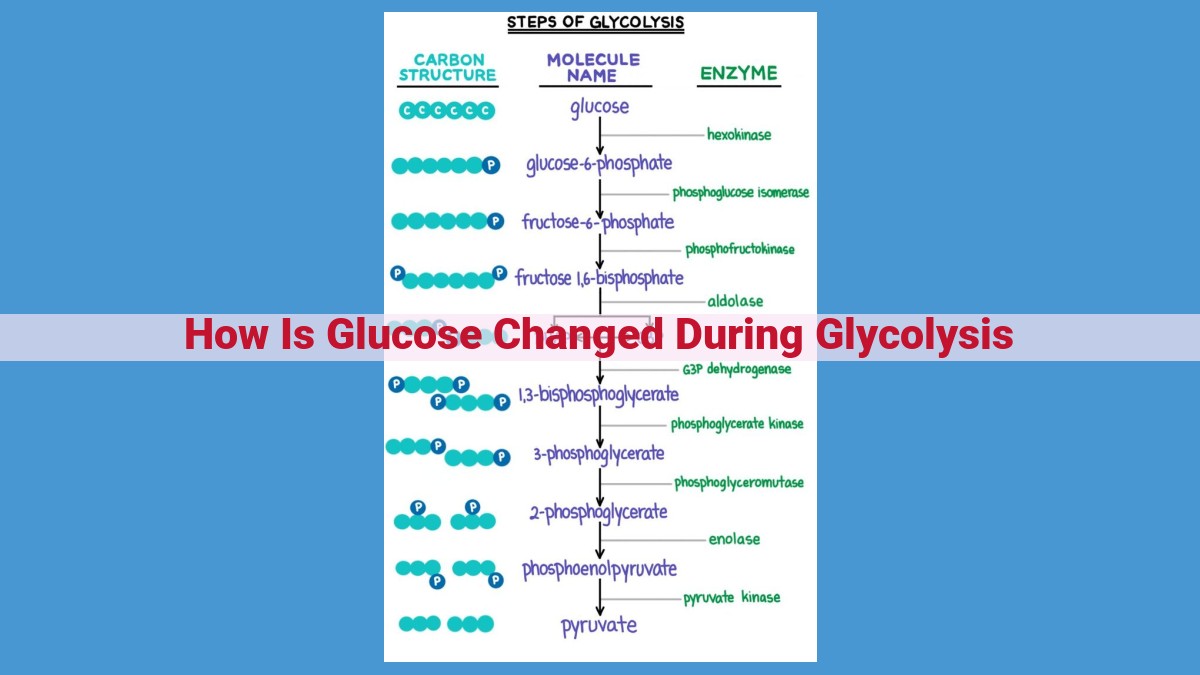During glycolysis, glucose undergoes a series of enzymatic reactions that break it down into two pyruvate molecules. This process generates two ATP molecules through substrate-level phosphorylation and two NADH molecules, which are high-energy electron carriers. The energy extracted from glucose via glycolysis is crucial for cellular metabolism and provides the foundation for subsequent energy-generating pathways, such as the citric acid cycle and oxidative phosphorylation.
Glycolysis: An Overview
- Definition of glycolysis and its significance in cellular respiration
- Steps involved in the breakdown of glucose into pyruvate
Glycolysis: The Kickstart to Cellular Respiration
In the bustling city of the cell, where countless biochemical reactions occur, glycolysis takes center stage as the opening act of cellular respiration. This vital process primes glucose, the body’s primary energy source, for the intricate dance of energy production.
Glycolysis unfolds in 10 orchestrated steps, each carefully choreographed to break down glucose into two molecules of pyruvate. As the glucose molecule is progressively fragmented, a remarkable transformation takes place: energy is released and captured in the form of ATP, the cell’s universal energy currency.
Energy Harvesting: ATP Production
Glycolysis marks the starting point of oxidative phosphorylation, the powerhouse of cellular respiration. During this process, the high-energy molecule NADH (nicotinamide adenine dinucleotide) is generated. NADH serves as a crucial electron carrier, transferring electrons along the respiratory chain, where they ultimately combine with oxygen to produce ATP.
NADH Generation: A Vital Role
NAD+ (nicotinamide adenine dinucleotide) plays a pivotal role in glycolysis, acting as an electron acceptor. As glucose is broken down, two molecules of NAD+ are reduced to NADH. These NADH molecules become essential substrates in the later stages of cellular respiration, fueling the production of ATP.
In summary, glycolysis sets the stage for cellular respiration by breaking down glucose and generating ATP and NADH. These molecules serve as crucial energy carriers, ultimately providing the power that fuels the body’s myriad functions. Understanding glycolysis is essential for comprehending the fundamentals of how cells generate energy.
ATP Production in Glycolysis: Fueling Cellular Energy
As we embark on our journey through the intricate world of cellular respiration, we encounter glycolysis, the foundational process where glucose is broken down into pyruvate. At this pivotal stage, not only is energy extracted, but a key molecule is produced that plays a crucial role in our cells’ energy production: ATP (adenosine triphosphate).
The Currency of Cellular Energy
ATP is the universal energy currency of cells. It’s like the rechargeable batteries that power our electronic devices, providing the energy for essential cellular processes such as muscle contraction, protein synthesis, and nerve impulse transmission.
Oxidative Phosphorylation: Generating ATP
Glycolysis generates two ATP molecules through a process called oxidative phosphorylation. This process involves the transfer of high-energy electrons from NADH (nicotinamide adenine dinucleotide) to the electron transport chain, a series of protein complexes embedded in the mitochondrial membrane.
As these electrons travel through the electron transport chain, their energy is harnessed to pump protons (H+) across the mitochondrial membrane. This creates an electrochemical gradient, with a high concentration of protons outside the mitochondria and a low concentration inside.
ATP Synthesis
The proton gradient drives the synthesis of ATP. As protons flow back into the mitochondria through a protein channel called ATP synthase, they release energy that is used to phosphorylate ADP (adenosine diphosphate) to ATP.
Summary
In summary, glycolysis generates ATP through oxidative phosphorylation. The transfer of electrons from NADH to the electron transport chain creates a proton gradient, which in turn drives the synthesis of ATP. These ATP molecules are the fuel that powers countless cellular processes, enabling our cells to perform the myriad of functions essential for life.
NADH Generation in Glycolysis: The Fuel for Aerobic Respiration
NAD+ as the Electron Carrier
In the bustling city of glycolysis, where glucose is broken down for energy, there’s a crucial player: NAD+, the electron carrier. Think of it as the tireless courier tasked with transporting tiny parcels known as electrons.
The Reduction of NAD+ to NADH
As glucose undergoes its transformation, NAD+ steps in to receive these electrons, becoming its reduced form, NADH. This reduction is akin to a switch being flipped, turning NAD+ from an empty carrier to one brimming with energy.
The Significance of NADH in Aerobic Respiration
NADH holds immense importance in the grand scheme of cellular energy production. When oxygen is present, this precious molecule serves as the fuel that powers aerobic respiration, a process where glucose is completely oxidized to yield a whopping 36-38 ATP molecules.
The Electron Transport Chain and ATP Production
NADH, laden with electrons, embarks on a perilous journey through a labyrinth known as the electron transport chain. This chain, residing within the mitochondria, is a series of intricate pumps that exploit the flow of electrons to generate an electrochemical gradient. This gradient drives the production of ATP, the cellular currency of energy.
